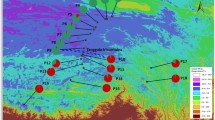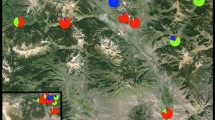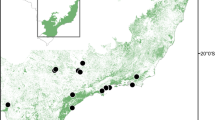Abstract
Contact zones are defined as areas where populations from different refugia meet during a postglacial expansion and distinct DNA lineages are mixedly distributed. In Japan, contact zones of various plants and animals were reported from the Kinki-Chugoku region. These contact zones appear to be maintained without any drastic topographic barriers such as those observed in the Alps and Pyrenees Mountains. In this study, the mechanisms underlying the formation and/or maintenance of these contact zones were investigated using six deciduous broad-leaved tree species (Carpinus laxiflora, C. tschonoskii, C. japonica, Magnolia obovata, Padus grayana, and Euonymus oxyphyllus). First, the precise location of the contact zones was examined by intensive genetic analysis of the six species. Second, the relationships between the geographic location of the contact zone and various environmental factors, including climate and topography, were investigated by generalized additive models to reveal the mechanisms of the formation and maintenance of the contact zones. As a result, four of the six examined plant species clearly showed a geographically common contact zone in Hyogo Prefecture and its adjacent areas. The results of the generalized additive models indicate that the pattern of low habitat suitability estimated by ecological niche modeling was the most important factor for determining the location of the common contact zone. These results suggest that areas with low habitat suitability in Hyogo Prefecture restrict the migration and gene flow of the four species in this region, and thus, they maintain the pattern of the contact zones. This study suggests that there are major effects of habitat suitability on the formation and maintenance of the contact zones.






Similar content being viewed by others
References
Aoki K, Suzuki T, Hsu TW, Murakami N (2004) Phylogeography of the component species of broad-leaved evergreen forests in Japan, based on chloroplast DNA variation. J Plant Res 117:77–94
Aoki K, Kato M, Murakami N (2005) Mitochondrial DNA of phytophagous insects as a molecular tool for phylogeographic study of host plants. Acta Phytotaxon Geobot 56:55–69
Aoki K, Kato M, Murakami N (2008) Glacial bottleneck and postglacial recolonization of a seed parasitic weevil, Curculio hilgendorfi, inferred from mitochondrial DNA variation. Mol Ecol 17:3276–3289
Aoki K, Kato M, Murakami N (2009) Phylogeographical patterns of a generalist acorn weevil: insight into the biogeographical history of broadleaved deciduous and evergreen forests. BMC Evol Biol 9:103. doi:10.1186/1471-2148-9-103
Aoki K, Kato M, Murakami N (2011) Phylogeography of phytophagous weevils and plant species in broadleaved evergreen forests: a congruent genetic gap between western and eastern parts of Japan. Insects 2:128–150
Aoki K, Ueno S, Kamijo T, Setoguchi H, Murakami N, Kato M, Tsumura Y (2014) Genetic differentiation and genetic diversity of Castanopsis (Fagaceae), the dominant tree species in japanese broadleaved evergreen forests, revealed by analysis of EST-associated microsatellites. PLoS One 9(1):e87429
Barton K (2012) Package ‘MuMIn’. Model selection and model averaging based on information criteria. R package version 1.7.11
Cicero C (2004) Barriers to sympatry between avian sibling species (paridae: baeolophus) in local secondary contact. Evolution 58:1573–1587
Clark JS, Lewis M, McLachlan JS, HilleRisLambers J (2003) Estimating population spread: what can we forecast and how well? Ecology 84:1979–1988
Ćosić N, Říčanová Š, Bryja J, Penezić A, Ćirović D (2013) Do rivers and human-induced habitat fragmentation affect genetic diversity and population structure of the European ground squirrel at the edge of its Pannonian range? Conserv Genet 14:345–354
Doyle JJ, Doyle JL (1987) A rapid DNA isolation procedure for small quantities of fresh leaf tissue. Phytochem Bull 19:11–15
Eidesen PB, Ehrich D, Bakkestuen V, Alsos IG, Gilg O, Taberlet P, Brochmann C (2013) Genetic roadmap of the Arctic: plant dispersal highways, traffic barriers and capitals of diversity. New Phytol 200:898–910
Fujii N, Tomaru N, Okuyama K, Koike T, Mikami T, Ueda K (2002) Chloroplast DNA phylogeography of Fagus crenata (Fagaceae) in Japan. Plant Syst Evol 232:21–33
Hall TA (1999) BioEdit: a user-friendly biological sequence alignment editor and analysis program for Windows 95/98/NT. Nucleic Acids Symp Ser 41:95–98
Harrison RG (1993) Hybrids and hybrid zones: historical perspective. In: Harrison RG (ed) Hybrid zones and the evolutionary process. Oxford University Press, Oxford, pp 3–12
Hartmann SA, Steyer K, Kraus RH, Segelbacher G, Nowak C (2013) Potential barriers to gene flow in the endangered European wildcat (Felis silvestris). Conserv Genet 14:413–426
Hewitt GM (1996) Some genetic consequences of ice ages, and their role in divergence and speciation. Biol J Linn Soc 58:247–276
Hewitt GM (1999) Post-glacial re-colonization of European biota. Biol J Linn Soc 68:87–112
Hewitt GM (2000) The genetic legacy of the Quaternary ice ages. Nature 405:907–913
Hewitt GM (2001) Speciation, hybrid zones and phylogeography—or seeing genes in space and time. Mol Ecol 10:537–549
Hewitt GM (2004a) Genetic consequences of climatic oscillations in the Quaternary. Philos Trans R Soc Lond Ser B Biol Sci 359:183–195
Hewitt GM (2004b) The structure of biodiversity—insights from molecular phylogeography. Front Zool 1:1–16
Hewitt GM (2011) Quaternary phylogeography: the roots of hybrid zones. Genetica 139:617–638
Higgins S, Clark J, Nathan R, Hovestadt T, Schurr F, Fragoso J, Aguiar M, Ribbens E, Lavorel S (2003) Forecasting plant migration rates: managing uncertainty for risk assessment. J Ecol 91:341–347
Ingvarsson PK, Ribstein S, Taylor DR (2003) Molecular evolution of insertions and deletions in the chloroplast DNA genome of silence. Mol Biol Evol 20:1737–1740
Iwasaki T, Tono A, Aoki K, Seo A, Murakami N (2010) Phylogeography of Carpinus japonica and Carpinus tschonoskii (Betulaceae) growing in Japanese deciduous broad-leaved forests, based on chloroplast DNA variation. Acta Phytotax Geobot 61:1–20
Iwasaki T, Aoki K, Seo A, Murakami N (2012) Comparative phylogeography of four component species of deciduous broad-leaved forests in Japan based on chloroplast DNA variation. J Plant Res 125:207–221
Jaramillo-Correa J, Beaulieu JPJ, Khasa DP, Bousquet J (2009) Inferring the past from the present phylogeographic structure of North American forest trees: seeing the forest for the genes. Can J For Res 39:286–307
Jaramillo-Correa J, Grivet JPD, Terrab A, Kurt Y, De-Lucas AI, Wahid N, Vendramin GG, Gonzalez-Martinez SC (2010) The Strait of Gibraltar as a major biogeographic barrier in Mediterranean conifers: a comparative phylogeographic survey. Mol Ecol 19:5452–5468
Kawamoto Y, Shotake T, Nozawa K, Kawamoto S, Tomari K, Kawai S, Shirai K, Morimitsu Y, Takagi N, Akaza H, Fujii H, Hagihara K, Aizawa K, Akachi S, Oi T, Hayaishi S (2007) Postglacial population expansion of Japanese macaques (Macaca fuscata) inferred from mitochondrial DNA phylogeography. Primates 48:27–40
McLachlan JS, Clark JS, Manos P (2005) Molecular indicators of tree migration capacity under rapid climate change. Ecology 86:2088–2098
Moritz C, Hoskin CJ, MacKenzie JB, Phillips BL, Tonione M, Silva N, VanDerWal J, Williams SE, Graham CH (2009) Identification and dynamics of a cryptic suture zone in tropical rainforest. Proc R Soc Biol Sci 276:1235–1244
Nagata J, Masuda R, Tamate HB, Hamasaki SI, Ochiai K, Asada M, Tatsuzawa S, Suda K, Tado H, Yoshida MC (1999) Two genetically distinct lineages of the Sika deer, Cervus nippon, in Japanese Islands: comparison of mitochondrial D-loop region sequences. Mol Phylogenet Evol 13:511–519
Ohnishi N, Uno R, Ishibashi Y, Tamate HB, Oi T (2009) The influence of climatic oscillations during the Quaternary Era on the genetic structure of Asian black bears in Japan. Heredity 102:579–589
Okamoto T, Hikida T (2009) Three genetic lineages of the Japanese skink Plestiodon japonicas (Scincidae, Squamata) and the genetic composition of their contact zones. J Zool Syst Evol Res 47:181–188
Phillips SJ, Dudík M (2008) Modeling of species distributions with Maxent: new extensions and a comprehensive evaluation. Ecography 31:161–175
Phillips SJ, Anderson RP, Schapire RE (2006) Maximum entropy modeling of species geographic distributions. Ecol Model 190:231–259
R Development Core Team (2013) R: a language and environment for statistical computing. R Foundation for Statistical Computing, Vienna
Remington CL (1968) Suture-zones of hybrid interaction between recently joined biotas. In: Dobzhansky T, Hecht MK, Steere WC (eds) Evolutionary biology. Appleton-Century-Crofts, New York, pp 321–428
Schmitt T (2007) Molecular biogeography of Europe: Pleistocene cycles and postglacial trends. Front Zool 4:11–13
Sekiguti T (1952) Some problem of climatic classification: A new classification of climates of Japan. In: Proceedings of 8th General Assembly, 18th Congr. of IGU, 285–290
Sota T, Hayashi M (2007) Comparative historical biogeography of Plateumaris leaf beetles (Coleoptera: Chrysomelidae) in Japan: interplay between fossil and molecular data. J Biogeogr 34:977–993
Sugahara K, Kaneko Y, Ito S, Yamanaka K, Sakio H, Hoshizaki K, Suzuki W, Yamanaka N, Setoguchi H (2011) Phylogeography of Japanese horse chestnut (Aesculus turbinata) in the Japanese Archipelago based on chloroplast DNA haplotypes. J Plant Res 124:75–83
Swenson NG (2006) Gis-based niche models reveal unifying climatic mechanisms that maintain the location of avian hybrid zones in a North American suture zone. J Evol Biol 19:717–725
Swenson NG, Howard DJ (2004) Do suture zones exist? Evolution 58:2391–2397
Swenson NG, Howard DJ (2005) Clustering of contact zones, hybrid zones and phylogeographic breaks in North America. Am Nat 166:581–591
Taberlet P, Fumagalli L, Wust-Saucy AG, Cossons JF (1998) Comparative phylogeography and postglacial colonization routes in Europe. Mol Ecol 7:453–464
Thiel-Egenter C, Holderegger R, Brodbeck S, Intrabiodiv Consortium, Gugerli F (2009) Concordant genetic breaks, indentified by combining clustering and tessellation methods, in two co-distributed alpine plant species. Mol Ecol 18:4495–4507
Waters JM, Fraser CI, Hewitt GM (2013) Founder takes all: density-dependent processes structure biodiversity. Trends Ecol Evol 28:78–85
Yasukochi Y, Nishida S, Han SH, Kurosaki T, Yoneda M, Koike H (2009) Genetic structure of the asiatic black bear in Japan using mitochondrial DNA analysis. J Hered 100:297–308
Yoshino MM (1980) The climatic regions of Japan (Die Klimaregionen Japans). Erdkunde 34:81–87
Acknowledgments
We thank Dr. F. Koike (Department of Risk Management and Environmental Sciences, Yokohama National Univ.), Dr. M. Saito (The Department of General Systems Studies, The Univ. of Tokyo), Mr. H. Mitsuhashi (The Museum of Human Activities Hyogo), Dr. H. Sato (Center for Ecological Research, Kyoto Univ.), Dr. I. Saeki (The Department of World Heritage Studies, Univ. of Tsukuba), Dr. J. Suzuki, Dr. T. Kusano, Dr. M. Kohri (Department of Biological Science, Tokyo Metropolitan Univ.), Dr. T. Sugawara, Dr. H. Kato, Dr. Y. Kakugawa, Mr. M. Nakaji, Mr. S. Shimokawa (Makino Herbarium, Tokyo Metropolitan Univ.), and two anonymous reviewers for their valuable advice. We also thank Dr. A. Ebihara (Department of Botany, National Museum of Nature and Science), Dr. M. Ito, and Mr. O. Kurashima (Department of General Systems Studies, The Univ. of Tokyo) for providing the occurrence data from the locality information of herbarium specimens deposited in the herbarium of National Science Museum, Tsukuba (TNS), and the results of the National Survey on the Natural Environment by the Ministry of the Environment, Japan (NSNE). This study was partly supported by the research project “A new cultural and historical exploration into human-nature relationships in the Japanese archipelago” of the Research Institute for Humanity and Nature (to N.M and A.S).
Author information
Authors and Affiliations
Corresponding author
Electronic supplementary material
Below is the link to the electronic supplementary material.
10265_2015_722_MOESM1_ESM.tif
Fig. S1 The contribution of each variable to the established model evaluated by regularized training gain. Red bars indicate “alone contributions”. Blue and green bars indicate “drop contributions” and contributions when all the variables are used, respectively (TIFF 29095 kb)
10265_2015_722_MOESM2_ESM.tif
Fig. S2 Geographical distribution of the common contact zone, as well as the eastern and western regions divided by the contact zone based on the mean mixed index values (M) among the four species. The sites in the eastern and western regions are indicated in blue and red, respectively, whereas those in the contact zone are indicated in green (TIFF 26335 kb)
10265_2015_722_MOESM3_ESM.tif
Fig. S3 Median joining network relationships among the cpDNA haplotypes in a Carpinus laxiflora, b C. tschonoskii, c C. japonica, d Magnolia obovata, e Padus grayana, and f Euonymus oxyphyllus. Black circles in the network indicate missing haplotypes. Solid bars, open bars, and stars in the networks indicate nucleotide substitution, indel, and inversions, respectively. Mononucleotide repeat variants were removed from this network analyses. The color of each haplotype corresponds to that in Fig. 2a–f (TIFF 14156 kb)
10265_2015_722_MOESM4_ESM.tif
Fig. S4 Scatter plot matrix of the mixed index (M) of the six species. Regression lines are shown in green (TIFF 15564 kb)
10265_2015_722_MOESM5_ESM.tif
Fig. S5 Estimated suitable habitats using the Maxent software for the four species: a Carpinus laxiflora, b C. tschonoskii, c C. japonica, and d Magnolia obovata (TIFF 21626 kb)
10265_2015_722_MOESM6_ESM.tif
Fig. S6 Principal component analysis of the climatic variables in the Kinki-Chugoku region. PC1 (x-axis) and PC2 (y-axis) explain 60 % and 23 % of the total variation, respectively. The climatic variables highly contributing to each component are shown. The sites in the contact zone, eastern region, and western region are indicated in green, blue and red, respectively. The number beside each mark corresponds to the collection site in Table S2 (TIFF 44087 kb)
Rights and permissions
About this article
Cite this article
Tono, A., Iwasaki, T., Seo, A. et al. Environmental factors contribute to the formation and maintenance of the contact zone observed in deciduous broad-leaved tree species in Japan. J Plant Res 128, 535–551 (2015). https://doi.org/10.1007/s10265-015-0722-y
Received:
Accepted:
Published:
Issue Date:
DOI: https://doi.org/10.1007/s10265-015-0722-y




